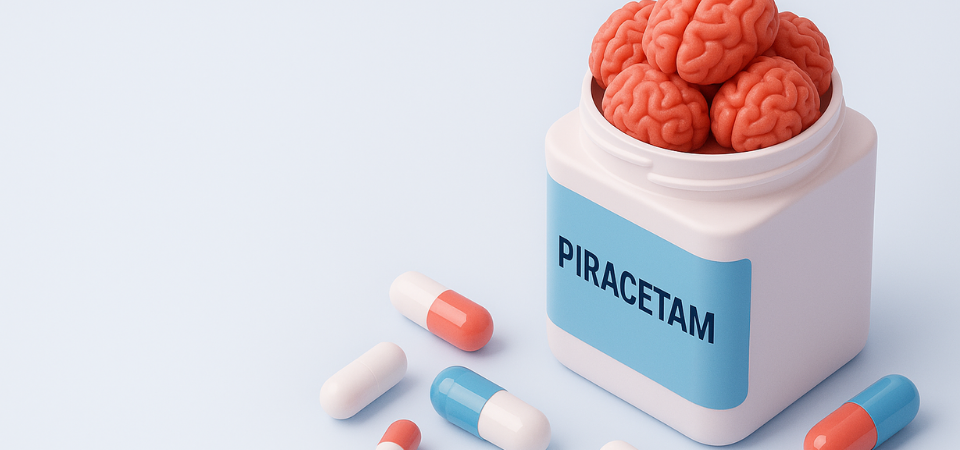What to know about the nootropic compound Piracetam

Piracetam holds a unique place in cognitive enhancement history as the first compound specifically developed to support brain function without causing sedation or stimulation. Synthesized in 1964 by Dr. Corneliu Giurgea at UCB Pharma, this water-soluble compound established the entire category of nootropics and continues to be extensively researched for its potential cognitive benefits.
For health-conscious individuals exploring evidence-based approaches to cognitive enhancement, understanding piracetam's mechanisms, applications, and safety profile provides valuable insight into one of the most studied nootropic compounds available. While regulations vary globally—with piracetam available as a prescription medication in many countries and as a dietary supplement in the United States—its decades of research offer substantial data on its effects and optimal usage patterns.
Whether you're a professional seeking cognitive edge, an athlete looking to enhance mental performance, or someone interested in long-term brain health optimization, piracetam's well-documented profile makes it worth understanding as part of a comprehensive wellness approach.
6 Essential Facts About Piracetam for Cognitive Enhancement
1. The Original Nootropic Compound
Piracetam represents a landmark achievement in neuroscience as the first compound specifically designed to enhance cognitive function without typical psychoactive side effects. This cyclic derivative of GABA belongs to the racetam family and established the foundational principles that define modern nootropics.
Unlike traditional stimulants or depressants, piracetam was developed to selectively support brain function while maintaining an excellent safety profile. Research suggests this compound works through multiple pathways rather than targeting a single neurotransmitter system, which may contribute to its broad cognitive applications.
Practical significance: Understanding piracetam's historical importance helps contextualize its role in modern cognitive enhancement strategies. As the prototype nootropic, it established safety and efficacy standards that continue to influence supplement development today.
2. Multi-Target Brain Mechanism
Piracetam's cognitive benefits appear to stem from its ability to modulate several key brain systems simultaneously. Studies indicate it may help support AMPA and NMDA receptor function—critical components in learning and memory processes—while enhancing acetylcholine activity, a neurotransmitter essential for attention and cognitive processing.
Research suggests piracetam may also support cerebral blood flow and oxygen utilization, potentially improving the brain's energy metabolism. Additionally, studies indicate it might enhance ATP production in brain cells and support neuroplasticity—the brain's ability to form new neural connections.
Practical application: This multi-target approach may explain why some users report diverse cognitive benefits, from improved memory formation to enhanced mental clarity. The compound's broad mechanism of action suggests it may complement other cognitive enhancement strategies rather than replacing them.
3. Research-Backed Cognitive Benefits
Clinical studies suggest piracetam may help support various aspects of cognitive function, though individual responses can vary significantly. Research indicates potential benefits for memory consolidation, learning capacity, and overall mental processing speed.
Studies have also explored piracetam's potential to support brain health during aging, with some research suggesting it may help maintain cognitive function in older adults. Additional studies indicate possible benefits for attention, mental flexibility, and information processing efficiency.
Important considerations: While research is promising, it's crucial to understand that cognitive enhancement is highly individual. Factors like genetics, lifestyle, overall health status, and concurrent medications can all influence how someone responds to piracetam supplementation.
4. Evidence-Based Dosage Guidelines
Research suggests effective piracetam dosages typically range from 1,600 mg taken three times daily, though individual needs may vary considerably. Some studies have used doses up to 9,600 mg daily, indicating a relatively wide therapeutic window, though such high doses should only be considered under professional guidance.
The compound's water-soluble nature means it's generally well-absorbed, though taking it with food may help reduce potential gastric irritation. Many users find starting with lower doses and gradually increasing based on individual response helps optimize benefits while minimizing side effects.
Implementation strategy: Begin with the minimum effective dose and assess your individual response over several weeks before considering adjustments. Consistency in timing and dosage appears more important than finding the "perfect" amount immediately.
5. Generally Well-Tolerated Safety Profile
Decades of research indicate piracetam has a relatively favorable safety profile, with most users experiencing minimal side effects. The most commonly reported issue is mild headaches, which research suggests may be related to increased acetylcholine demand in the brain.
Studies indicate piracetam is non-toxic at recommended doses, with no evidence of addiction potential or significant drug interactions with common medications. However, as with any supplement, individual tolerance can vary, and some people may experience mild digestive upset or sleep disturbances if taken too close to bedtime.
Safety considerations: While generally well-tolerated, it's important to consult with a healthcare provider before starting piracetam, especially if you have existing health conditions or take prescription medications. Pregnant or nursing women should avoid use due to insufficient safety data.
6. Synergistic Stacking Potential
Many piracetam users report enhanced benefits when combining it with choline supplements like Alpha GPC or CDP-choline. This combination makes theoretical sense, as piracetam may increase acetylcholine utilization, potentially creating higher demand for choline, the precursor to this important neurotransmitter.
Research suggests this stacking approach may help minimize headaches—the most common piracetam side effect—while potentially enhancing cognitive benefits. Some users also combine piracetam with other nootropics, though such combinations should be approached cautiously and preferably under professional guidance.
Practical implementation: If considering a piracetam and choline stack, start with conservative doses of both compounds and monitor your response carefully. Individual needs for choline supplementation vary widely, so finding your optimal ratio may require patience and experimentation.
Making Informed Decisions About Piracetam
Piracetam's extensive research history and generally favorable safety profile make it an interesting option for those exploring cognitive enhancement strategies. However, like all supplements, its effects are highly individual, and what works well for one person may not provide the same benefits for another.
The key to successful piracetam use lies in realistic expectations, consistent dosing, and careful attention to your individual response. Starting conservatively, maintaining detailed records of effects, and being patient with the process can help maximize potential benefits while minimizing risks.
Remember that cognitive enhancement extends far beyond supplementation. Quality sleep, regular exercise, stress management, and proper nutrition form the foundation of optimal brain function. Piracetam may help support these fundamentals, but it cannot replace them. Always consult with a qualified healthcare provider before beginning any new supplement regimen, especially if you have existing health conditions or take prescription medications.



